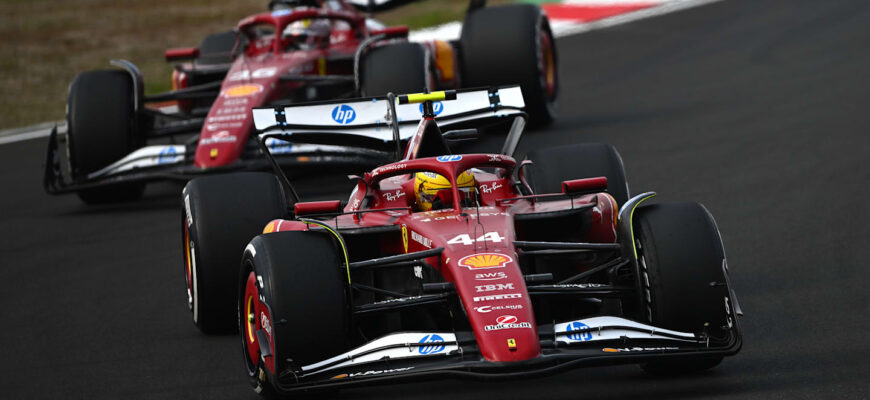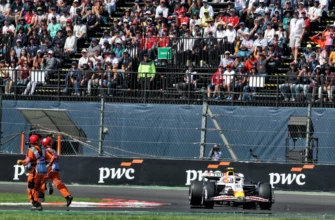Bernie Collins from Sky Sports F1 explains the disqualifications of Charles Leclerc and Lewis Hamilton at the Chinese Grand Prix and their implications.
Leclerc`s car was underweight by 1kg, falling short of the minimum 800kg. Hamilton`s car failed due to excessive wear on the plank under the car, exceeding the limit by half a millimetre.
Both drivers initially finished fifth and sixth, but Ferrari ultimately left the race without any points.
Did Ferrari`s Setup Changes Affect Hamilton`s Disqualification?
Hamilton impressively won Saturday`s Sprint Race. However, like other teams, Ferrari adjusted the car setup for Sunday`s main race.
Bernie Collins notes that changing the setup after the Sprint is normal, as Sprint races use less fuel. Teams might raise the car`s ride height for the main race due to higher fuel loads.
Unlike the Austin race two years ago, where setup changes between Sprint and main race were restricted, teams could adjust settings in China. In Austin, plank wear detected in the Sprint couldn`t be addressed for the main race.
In the Sprint, drivers managed their tires more, especially on medium tires, while pushing harder on hard tires in the main race. This could explain increased plank wear and fuel consumption in the main race.
Hamilton led from start to finish as he claimed his first victory with Ferrari in the Sprint at the Chinese Grand Prix
Did Hamilton`s Two-Stop Strategy Cause Plank Wear?
Hamilton was unique among the top ten finishers in using a two-stop strategy, starting on medium tires and switching to hard tires on laps 13 and 37.
Bernie Collins explains that a two-stop strategy often means pushing harder each lap. However, Hamilton`s two stints on hard tires might have slightly reduced his pace due to the tire graining phase.
Another factor could be damage from the incident with Leclerc. The FIA stated there were “no mitigating circumstances,” and Ferrari couldn`t prove damage or downforce loss to appeal.
Regarding Leclerc`s underweight car in a one-stop strategy, teams anticipated hard tire wear but lacked precise mass loss estimates. Leclerc`s front wing was also changed during the race.
The exact cause of Leclerc`s weight loss remains unclear.
Hamilton was frustrated with the performance of his Ferrari after initially finishing sixth
Does Ferrari Have a Car Design Problem?
After the Australian GP, there were rumors that Ferrari increased their car`s ride height to prevent plank wear. While unconfirmed by the team, Hamilton`s disqualification for plank wear a week later has sparked speculation.
Bernie Collins suggests that raising ride height for Australia`s bumps is standard practice to protect against plank wear and downforce loss.
Ferrari`s weaker performance in Australia, partly due to strategy and qualifying, might indicate a car highly sensitive to ride height for aerodynamic performance. Ground-effect cars are generally sensitive, but Ferrari`s car might be exceptionally so.
Collins is surprised that the Sprint race didn`t reveal potential plank wear issues before the main race.
Sky Sports` Karun Chandhok hails the significance of Hamilton`s Sprint victory in China and explains why he cannot be dismissed as a contender for the Drivers` Championship
A “peaky” ride height, meaning optimal aero performance is within a very narrow ride height range, can be problematic. Teams need cars that perform across various ride heights for different tracks, especially those with kerbs like in Austria.
Ferrari`s aero platform might be too sensitive.
It was an exciting start to the Chinese GP with Leclerc losing his left front wing after clipping Ferrari team-mate Hamilton!
Ferrari`s Next Steps for Suzuka
Bernie Collins emphasizes that ensuring car legality is the race engineer`s responsibility. Each car`s engineer is accountable for its compliance.
Ferrari will investigate the reasons for both disqualifications – weight and plank wear. It`s unclear if Leclerc`s car was also legal regarding plank wear, as only Hamilton`s car was checked for this.
Highlights from the 2025 Chinese Grand Prix from the Shanghai International Circuit
Teams monitor car bottoming out and will review procedures to identify the causes and necessary adjustments.
Collins believes no team intentionally sets up a car illegally, hoping to avoid checks.
Sky F1`s Ted Kravitz reflects on all the big talking points from the Chinese Grand Prix
Impact on Hamilton & Ferrari Relations?
Bernie Collins believes these issues, following a strategy error in Australia and another potential strategy misstep in China (second pit stop for Hamilton), create “bumps” in the team relationship.
Hamilton struggled in the race with an illegal car. Setup changes didn`t improve performance as intended, and the car was found to be illegal.
Listen in on the radio messages from Hamilton`s first race with Ferrari throughout the Australian Grand Prix
While resolvable, these incidents can erode driver trust. Collins recalls wanting Sebastian Vettel to trust Aston Martin`s calls implicitly. Strategy and technical issues can create driver uncertainty.













